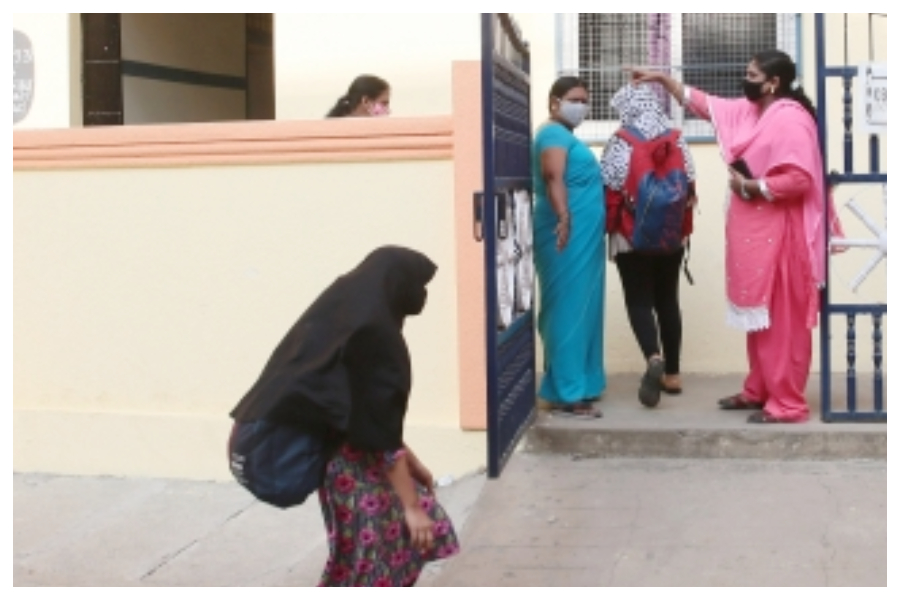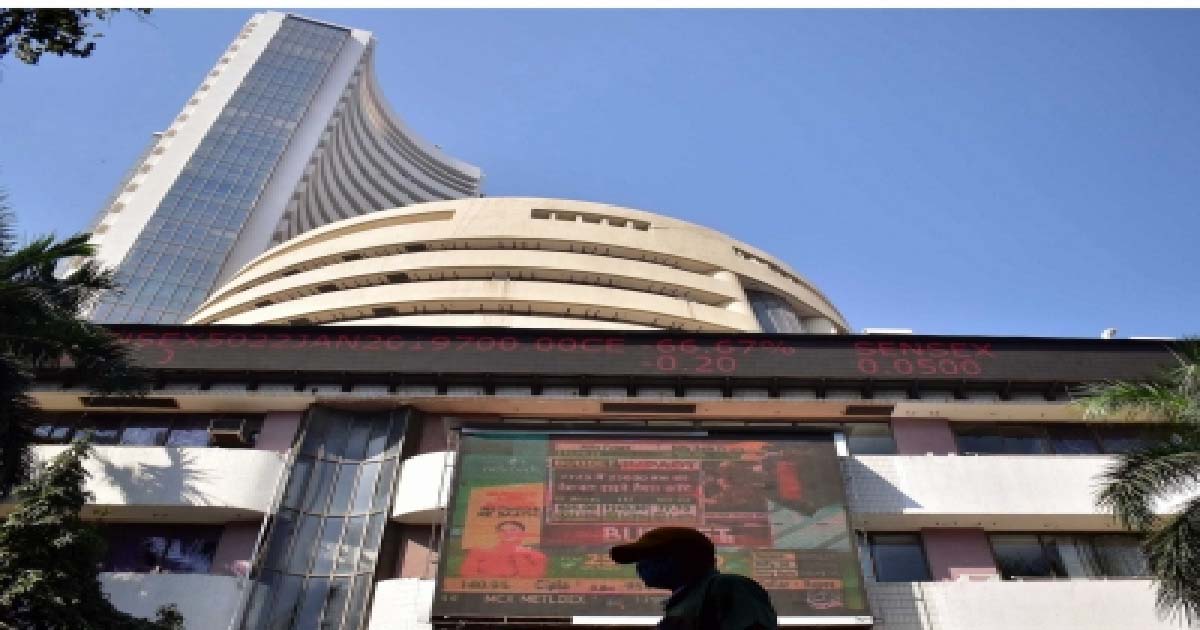National News
Tense situation continues in K’taka colleges as hijab wearing Muslim students sent back

Tense situation continued in and around Karnataka colleges on Thursday as the pre-university students wearing hijab demanded to be let inside classrooms. The hijab-clad students were sent back and many protested the decision of college authorities.
Six persons, who came in support of the hijab wearing students near the Vijay Para-Medical College, were taken into custody in Belagavi. The individuals who gathered in front of the college raised ‘Allah hu Akbar’ slogans and demanded that hijab wearing students must be allowed inside the classrooms. They were taken into custody after they indulged in heated arguments with the police.
State Home Minister Araga Jnanendra met Chief Minister Basavaraj Bommai at his residence and discussed the situation in the state. Meanwhile, Muskaan Khan, the student who made international news by raising ‘Allah hu Akbar’ slogans against saffron wearing protesting students, remained absent from PES College in Mandya.
Deputy Commissioner Rakesh Kumar of Ramnagar district issued prohibitory orders and cancelled physical classes in the district. The First Grade PUC college administration has been asked to take online classes till February 19. More than 20 students of Government Women’s PU College in Vijayapura wearing hijab refused to take up exams. The local police clamped prohibitory orders on 200 meters radius of the college and tight security has been arranged.
Prohibitory orders have also been clamped in Hubballi till February 28 to not allow any protests. Meanwhile, a one-day holiday has been announced for Hubballi Arts and Commerce College to avoid any untoward incidents due to the hijab row.
Tension prevailed at Shivamogga DVS College when more than 20 hijab wearing students tried to get inside the college. Police and college authorities sent them back. AAPUC Chemistry Practical exams scheduled to be held on Thursday were postponed in Udupi MGM College.
Students at Sarala Devi College in Bellary questioned how can Hindu students be allowed inside the campus while wearing bindi, bangles and they also be sent out. The students got into an argument with the police for preventing them from entering the premises of the college.
Students wearing hijab were sent back from Belagavi RLS College, Koppal colles, Ballary Veerashaiva Mahila colleges.
Crime
Woman tourist harassment case: Two Kerala cops suspended, two taxi drivers arrested (Lead)

Thiruvananthapuram, Nov 3: In a swift action following the viral video of a woman tourist being harassed by local taxi drivers in Munnar, the Kerala Police, on Monday, have suspended two officials and taken two taxi drivers — identified as Vinayakan and Vijayakumar — into custody.
The case has sparked widespread outrage on social media, prompting the state government to promise corrective steps to ensure tourist safety in the hill station.
The video, originally posted by Janvi, a Mumbai-based assistant professor, showed a group of taxi drivers confronting and intimidating her and her friends for booking an online cab instead of a local taxi near the KSRTC bus stand in Munnar on October 30.
The drivers, reportedly opposed to app-based taxi services, allegedly warned the tourists that they would not be allowed to travel unless they hired local taxis.
Janvi alleged that when she approached the police for help, officers failed to act, echoing the stance of the taxi union.
“We were forced to take another vehicle and eventually cut short our trip out of fear,” she said in the video, which has since been deleted but had already gone viral.
Following the public outcry, the Munnar police registered a suo motu case under Sections 126(2), 351(2), and 3(5) of the Bharatiya Nyaya Sanhita, relating to wrongful restraint and criminal intimidation.
The FIR did not initially name any accused, but police have since identified three taxi drivers, two of whom are in custody, with the third expected to be taken into custody soon.
State Tourism Minister P.A. Mohammed Riyas called the incident “unfortunate” and said it “should never have happened,” adding that steps will be taken to strengthen police vigilance and prevent the harassment of tourists in the future.
The incident has reignited debate over the monopoly of local taxi unions in tourist destinations and the challenges faced by app-based cab services in Kerala.
Entertainment
Kartik Aaryan-starrer ‘Tu Meri Main Tera, Main Tera Tu Meri’ hops on December 25 release after ‘Alpha’ moves to April

Mumbai, Nov 3: Bollywood is a place where timing is of essence. Be it the box-office clashes or their aversion, timing plays a huge role in how things play out on the ticket windows.
The Kartik Aaryan-starrer ‘Tu Meri Main Tera, Main Tera Tu Meri’, which was earlier scheduled to close the entertainment year on December 31, 2025, now has a new release date. The film is set to arrive in cinemas on December 25, 2025.
Over the past few years, Kartik Aaryan has emerged as one of the most bankable stars in the country, consistently delivering hits across genres. Whether it’s a mass entertainer, a romantic drama, the actor’s name alone now commands strong box office openings. His relatability, charm, and growing stardom have positioned him as the face of the new-age commercial cinema, someone who bridges the gap between youth appeal and family audiences.
However, the true star power also lies in being smart with the release of the films. The change in the release date of the film comes shortly after Alia Bhatt-starrer ‘Alpha’ vacated December 25, and shifted to April 17, 2026. Kartik, and the makers made a quick decision to consolidate the closing week of 2025 at the box-office.
With Tu Meri Main Tera, Main Tera Tu Meri, Kartik seems to have found his festive rhythm from lighting up Diwali with laughter and emotion in Bhool Bhulaiyaa 3 to now taking over Christmas with love and melody. Well, the excitement is sky rocketing amongst the audience and business.
The film also marks the reunion of Kartik Aaryan and Ananya Panday, who are all set to recreate their sizzling on-screen chemistry after years. They were earlier seen together in ‘Pati Patni Aur Woh’.
Produced by Dharma Productions and Namah Pictures, the rom-com is directed by Sameer Vidwans, with whom Kartik delivered the much-loved romantic drama ‘Satyaprem Ki Katha’.
Business
Indian stock markets end higher after two days of losses

Mumbai, Nov 3: Indian equity markets ended a volatile session on a positive note on Monday, snapping a two-day losing streak.
Gains in real estate and state-owned bank stocks helped lift the indices despite early weakness.
After opening lower, the Sensex recovered to touch an intra-day high of 84,127 before closing 39.78 points, or 0.05 per cent, higher at 83,978.49.
The Nifty also gained 41.25 points, or 0.16 per cent, to end at 25,763.35.
“The Nifty oscillated between 25,700 and 25,800 through the day, showing resilience after briefly dipping below the October 24 low of 25,718,” analysts said.
“The zone between 25,660–25,700 once again acted as a strong demand pocket, helping the index recover intraday losses and maintain a constructive tone ahead of key global data releases,” they added.
Among the Sensex stocks, Maruti Suzuki fell over 3 per cent and was among the top losers along with Titan Company, BEL, TCS, ITC, NTPC, Bajaj Finserv, Tata Steel and tech Mahindra.
On the other hand, Mahindra & Mahindra, State Bank of India, Tata Motors Passenger Vehicles, and HCL Tech were the major gainers.
In the broader markets, the Nifty MidCap index rose 0.77 per cent, while the Nifty SmallCap index advanced 0.72 per cent, showing strength beyond the frontline stocks.
Among sectoral indices, PSU bank shares led the rally, with the Nifty PSU Bank index climbing 1.92 per cent.
Bank of Baroda surged 5 per cent, while Canara Bank, Bank of Maharashtra, Bank of India, and Indian Bank also gained.
The Nifty Metal and Realty indices also added up to 2 per cent each.
Meanwhile, the FMCG, Private Bank, and IT indices slipped up to 0.4 per cent, capping the market’s overall gains.
Analysts said that despite mixed global cues and cautious investor sentiment, buying in select sectors helped the markets end the day in the green.
“The domestic market ended on a marginal positive note as profit booking was visible at the higher levels due to the absence of fresh domestic triggers,” market watchers said.
“While the broader market outperformed since the quarterly earnings are steering investors’ preference to take a short- to medium-term view,” they mentioned.
-

 Crime3 years ago
Crime3 years agoClass 10 student jumps to death in Jaipur
-

 Maharashtra1 year ago
Maharashtra1 year agoMumbai Local Train Update: Central Railway’s New Timetable Comes Into Effect; Check Full List Of Revised Timings & Stations
-

 Maharashtra1 year ago
Maharashtra1 year agoMumbai To Go Toll-Free Tonight! Maharashtra Govt Announces Complete Toll Waiver For Light Motor Vehicles At All 5 Entry Points Of City
-

 Maharashtra1 year ago
Maharashtra1 year agoFalse photo of Imtiaz Jaleel’s rally, exposing the fooling conspiracy
-

 National News1 year ago
National News1 year agoMinistry of Railways rolls out Special Drive 4.0 with focus on digitisation, cleanliness, inclusiveness and grievance redressal
-

 Maharashtra12 months ago
Maharashtra12 months agoMaharashtra Elections 2024: Mumbai Metro & BEST Services Extended Till Midnight On Voting Day
-

 National News1 year ago
National News1 year agoJ&K: 4 Jawans Killed, 28 Injured After Bus Carrying BSF Personnel For Poll Duty Falls Into Gorge In Budgam; Terrifying Visuals Surface
-

 Crime1 year ago
Crime1 year agoBaba Siddique Murder: Mumbai Police Unable To Get Lawrence Bishnoi Custody Due To Home Ministry Order, Says Report












